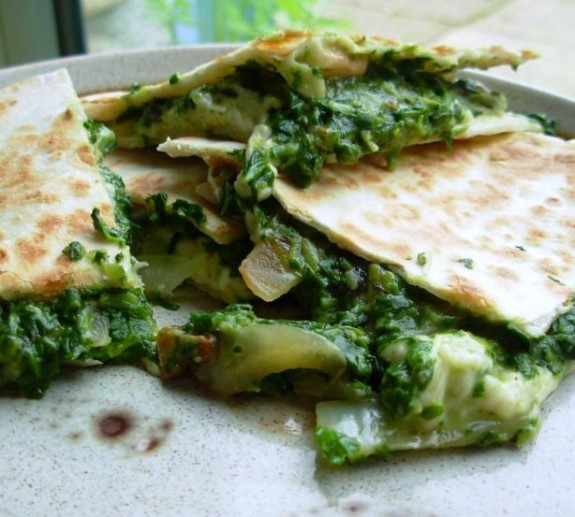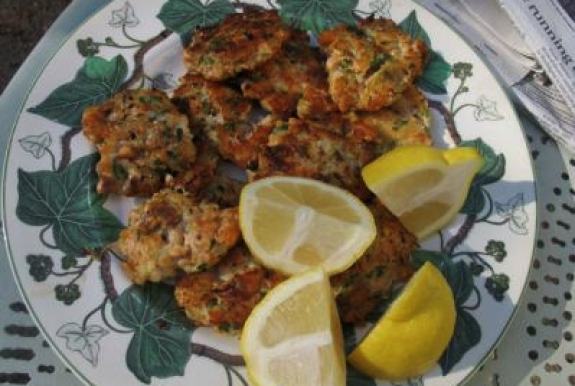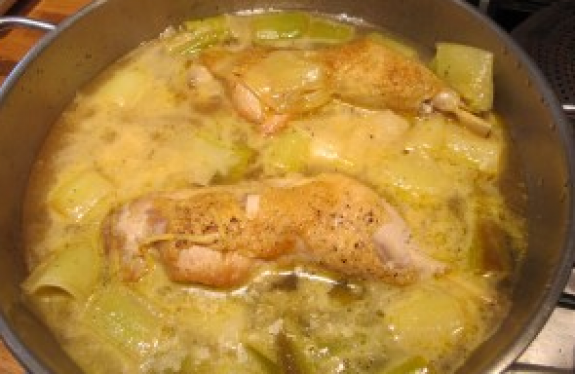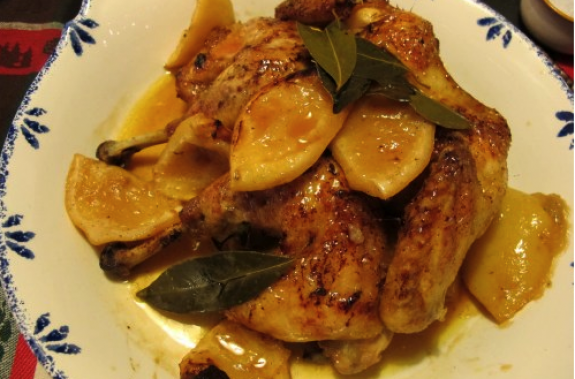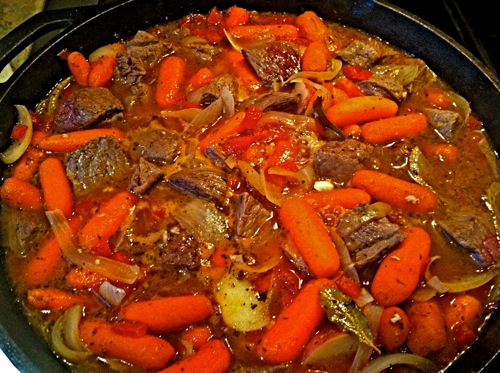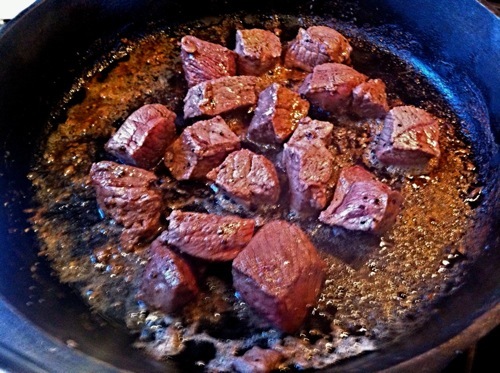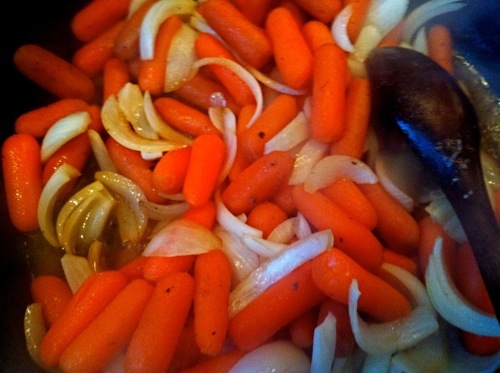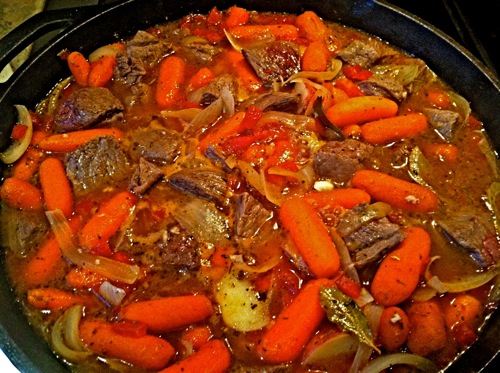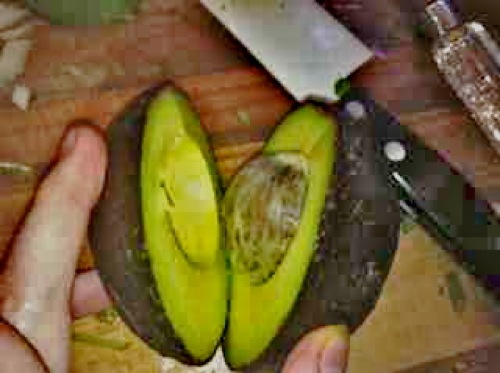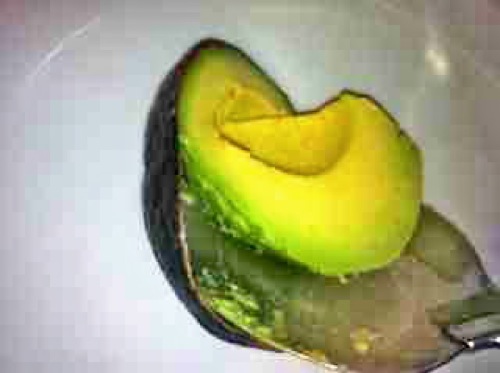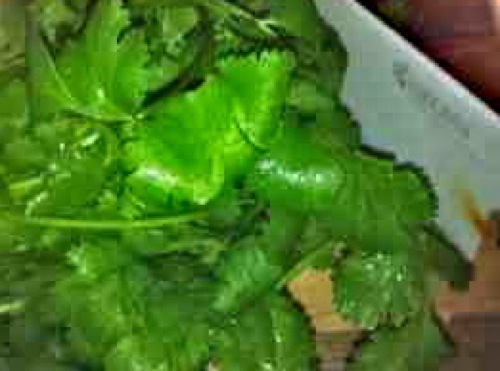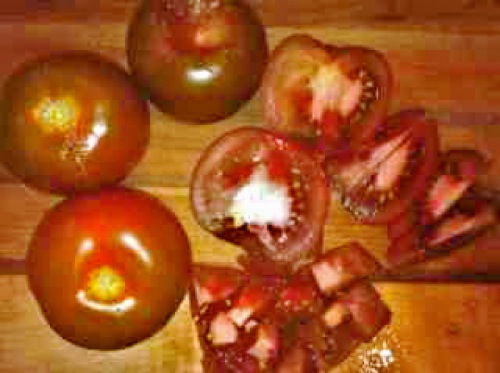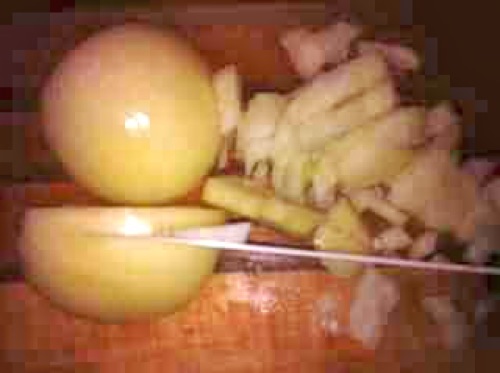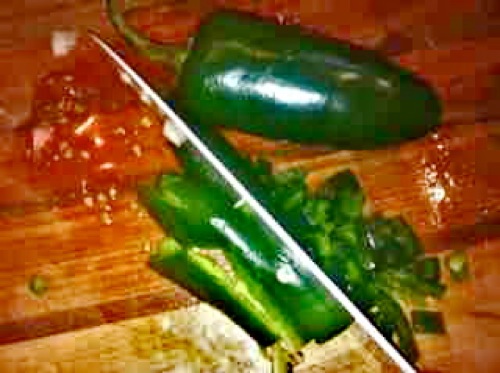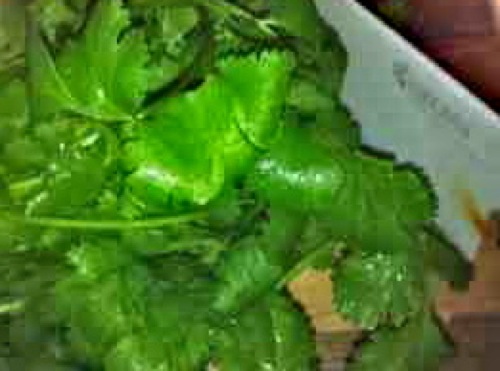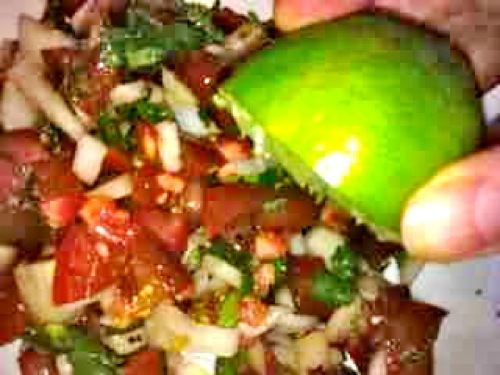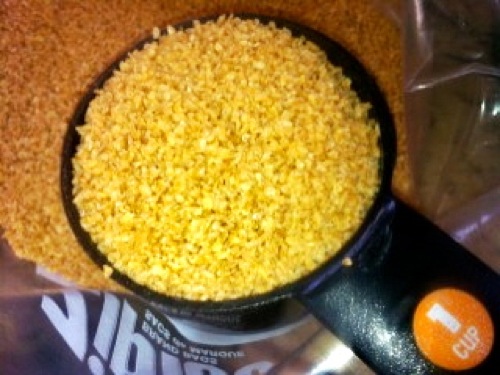Eggs Scrambled with Onion, Garlic, Kale and Sweet Cherry Tomatoes
- At March 16, 2012
- By Katherine
- In Recipes
 0
0
Eggs Scrambled with Onion, Garlic, Kale and Sweet Cherry Tomatoes
This is a regular meal for me any time of the day – quick, easy, delicious, nutritious!
Servings: 1
Saute 1/4 sweet onion and a smashed garlic clove over medium high heat in 1 teaspoon canola or olive oil until almost soft. Add a handful of chopped kale and tomatoes to the pan (or any other vegetables you happen to have such as chopped spinach, kale, mushrooms, or peppers) and cook for another 5 minutes. Turn down heat to very low. In a separate bowl, whisk 2 eggs. Pour eggs into the pan containing the onion, garlic and tomato – add 1 ounce low fat cheese, if you wish. Stir continuously until eggs are cooked. Pour over toasted whole rye bread.
Deep Green Leafy Vegetables have the highest antioxidant content of all vegetables. High in fiber, they are rich in minerals, B-vitamins, beta-carotene, and lutein, a compound which may help reduce the risk of age-related macular degeneration (the leading cause of preventable blindness). Absorption of carotenoids, such as lutein, in your body is increased by cooking and by the presence of fat (so cook in a little healthy olive or canola oil!)
Roberto Donna’s White Beans, Kale and Shrimp Salad with Basil Dressing
- At March 16, 2012
- By Katherine
- In Recipes
 0
0
Roberto Donna’s White Beans, Kale and Shrimp Salad with Basil Dressing
excerpted from “Diet Simple”
4 servings
8 oz. Dry Cannellini Beans (or 24 ounces canned, rinsed)
1/2 bunch Kale, cleaned, tough stems removed, chopped
1/ 2 Peeled Onion
1 Celery Stalk
4 Fresh Sage Leaves
1/2 Medium Carrot
8 oz. Shrimp (optional, if using shrimp)
2 Cups White Wine (for cooking the shrimp, if using shrimp)
1 Tbsp Balsamic Vinegar
3 Tbsp Extra Virgin Olive Oil
10 Fresh Basil Leaves
Salt and Pepper to Taste
Optional step if starting with dried beans: Soak the cannellini beans in water for 12 hours; drain and place in a pot of water, add salt and pepper; cover and simmer for 45 minutes.
Optional step if using dried beans: Chop and add the onion, celery and carrot, cooking another ten minutes. Add the finely diced sage to the pot and drain the cooking liquid. Place in a cool location.
If using canned beans: Rinse the beans in a strainer, add to a large bowl. Chop all of the vegetables and the fresh sage leaves and add to the beans. Toss beans, vegetables and sage together.
If using shrimp: Wash and clean the shrimp and poach for three minutes, or until done, in the White Wine.
Add salt and pepper to taste.
Dressing: Finely chop basil and add the balsamic vinegar, salt, pepper and olive oil. Whisk until emulsified.
Presentation: Place a large, clean Kale leaf and 1/4 of the mixture on each plate. Top with 2 oz. of the shrimp and a drizzle of the basil dressing.
As a James Bread Award winning Chef and Restaurateur in Washington, DC, Roberto Donna is committed to introducing others to the real flavors of Italy, which he provides in his seven restaurants. Born in Torino, the Piedmont Region of Italy, Roberto Donna’s fervent mission is the promotion of his authentic Italian cuisine.
Carla Hall’s Hearty Greens Salad with Warm Balsamic Cherry Vinaigrette
- At March 16, 2012
- By Katherine
- In Recipes
 0
0
Carla Hall’s Hearty Greens Salad with Warm Balsamic Cherry Vinaigrette
Excerpted from “Diet Simple”
8 servings
6 c (1 pound) Mixed Hearty Greens (Kale, Rape, Collards, and/or Mustard), washed well, stems removed, rolled and cut thinly (chiffonade)
4 T Canola Oil
2 T Balsamic Vinegar
1 T Dijon Mustard
2 t Honey
Salt and Pepper to taste
½ c Cherries, pitted and halved
¼ Red Onion, sliced thinly
1. In a medium saucepan, heat the oil over medium heat.
2. While the oil is heating, combine the balsamic, mustard and honey in a small bowl. Just before the oil starts to smoke, add the balsamic vinegar and stir to combine. Let the mixture come to a boil, and continue to stir.
3. If it is too thick or too strong with vinegar, add a dash of water. Season with salt and pepper.
4. Add the cherries to the mixture. Toss the greens with just enough vinaigrette to wilt the greens, then drizzle additional vinaigrette around the plate. Garnish the salad with rings of red onion.
Deep Green Leafy Vegetables have the highest antioxidant content of all vegetables. High in fiber, they are rich in minerals, B-vitamins, beta-carotene, and lutein, a compound which may help reduce the risk of age-related macular degeneration (the leading cause of preventable blindness). Absorption of carotenoids, such as lutein, in your body is increased by cooking and by the presence of fat (so cook in a little healthy olive or canola oil!).
Carla Hall, Top Chef finalist, is the owner and chef of Alchemy Caterers, a catering and private chef company in Washington, D.C. She teaches cooking classes at Culinaerie, as well as team building classes at different venues in the metropolitan area.
Kale Recipe Quest: Making this “Superfood” Delicious!
- At March 16, 2012
- By Katherine
- In News, Recipes
 0
0
Kale: does it evoke rapture? Anticipation? I fear you may be scrunching your face at the mention of kale. I completely understand! I’m constantly looking for ways of making kale and other deep green leafy vegetables delicious, and regularly surprised at how easy it actually is. If you can let go of any skepticism and trust me on this, I think you will be very pleased, too…
Do you have kale recipes you’d like to share? In my “Kale Recipe Quest,” here are some of my favorites. I’d love to know what you think…
Carla Hall’s Hearty Greens Salad with Warm Balsamic Cherry Vinaigrette
Roberto Donna’s White Beans, Kale and Shrimp Salad with Basil Dressing
Janis McLean’s Kale Quesadillas with Chipoltle Salsa
Eggs Scrambled with Onions, Garlic, Kale and Sweet Cherry Tomatoes
Deep Green Leafy Vegetables have the highest antioxidant content of all vegetables. High in fiber, they are rich in minerals, B-vitamins, beta-carotene, and lutein, a compound which may help reduce the risk of age-related macular degeneration (the leading cause of preventable blindness). Absorption of carotenoids, such as lutein, in your body is increased by cooking and by the presence of fat (so cook in a little healthy olive or canola oil!)
A Selection of Robin Ellis’s Mediterranean Recipes
- At February 28, 2012
- By Katherine
- In News, Recipes
 0
0
I’m completely charmed and impressed by Robin Ellis’ enthusiasm for his new healthy lifestyle; the Mediterranean lifestyle and diet I have adopted and a way of life I encourage everyone I know and love to embrace as well.
Ellis, a British star of stage and screen, was diagnosed with Type 2 Diabetes, and since then has been dedicated to a life of good health, but without deprivation. Based on Mediterranean cuisine – one of the healthiest in the world – Robin Ellis, in his book and blog, shares his lifetime collection of healthy recipes. Inside, you’ll find:
* Simple yet sublime recipes that work,
* Dishes that all the family can enjoy,
* Not a quick-fix diet but a way of eating for everyday life.
Some samples…
Salmon Fishcakes with a Sauce of Mustard and Dill
It’s like a crabcake – only with Salmon – delicious!
A Dish of Chicken and Leeks with Lemon
Spicy Chickpeas – Lightly Sauteed
Spatchcocked Chicken with Lemon and Bay Leaf
The French Culinary Institute’s Veal Stew with Carrots, La Boutarde: A Step-by-Step Pictorial Guide
Excerpted from Diet Simple
This stew is perfect for a chilly winter day, in front of a fire, with good friends, glasses of wine clinking. My client, Lloyd, and I made this stew yesterday using beef round cubes instead of veal and it took less than 30 minutes’ working time. Though it needs to simmer anywhere from 1 to 2 hours for the very lean beef or veal to become tender, almost to the point of falling apart – and melting in your mouth (Lloyd insisted we imbibe just a little while cooking – I acquiesced). As Lloyd and I were wrapping up our lesson, my next client Alex popped in and was immediately transfixed by the aromas. After a taste: “Delicious! I’m making it this weekend!” she said. No surprise there, as this beautiful and simple recipe is adapted from one of my favorite cookbooks: “The French Culinary Institute’s Salute to Healthy Cooking.”
The measurements do not need to be precise. You can add more vegetables, like celery, turnips, almost anything.
The veal rump is found at a butcher’s or specialty market (in Washington, D.C., that would be Eastern Market). But call ahead to be sure, and ask the butcher to chop it into stew meat cubes. A substitute would be veal shoulder, which is typically used for stews, but it is not as lean as the rump. If you’re on a budget or do not have a butcher easily accessible, beef round cubes are an excellent substitute.
4 servings (when you quadruple the vegetables, it will make at least 6 servings, each with more vegetables and less meat)
Ingredients:
1 Tablespoon Extra Virgin Olive Oil or Canola Oil
2 Pounds Veal Rump, well trimmed and cut into 2-inch cubes, seasoned with Salt and Freshly Ground White Pepper
2 Medium Carrots, cut into 1/2-inch slices (I quadruple the carrots)
1 Medium Onion, chopped
1-1/2 Cups Dry White Wine
1 Cup Water (or more Wine)
2 Medium Very Ripe Tomatoes, peeled, cored, seeded, and chopped (Canned Plum Tomatoes are terrific – again, I quadruple the amount)
2 teaspoons Herbes de Provence*
1 Bay Leaf
3 Small All-Purpose Potatoes, quartered (I like using the small new potatoes)
Directions:
Warm the oil in a large saute pan over medium-high heat. When hot, add no more than half the veal and sear for 3 minutes, or until the veal has evenly browned on all sides. Do not crowd the pan or scorch the meat. Using a slotted spoon, transfer the veal to a Dutch oven. Continue searing the veal until all of the meat has been browned. Season with salt and pepper.
In the same pan over medium heat, saute the carrots and onions for 3 to 5 minutes, or until the onions are translucent. Lloyd decided to simplify and used baby carrots.
Reduce the heat and stir in the wine. Using a wooden spoon, stir vigorously to lift the browned bits from the bottom of the pan.
Pour into the Dutch oven (or keep everything in your saute pan if it is big enough). Add the water (or Wine), Tomatoes, Herbes de Provence*, and the Bay Leaf (Lloyd decided to add mashed garlic). Place over medium heat and bring the stew to a boil. Reduce the heat to medium-low, cover, and simmer for one hour. Add the potatoes and simmer for 35 minutes, or until the potatoes and meat are tender (it may take a total of 2 hours of simmering for the meat to become melt-in-your-mouth tender).
Taste and adjust the seasoning. Remove the bay leaf. Voila!
*Herbes de Provence is a mixture of dried herbs that often includes basil, lavender, rosemary, sage, thyme, and others. Look for it in the spice section of your supermarket.
Nutrition information per serving: 437 calories, 12 g total fat, 4 g sat fat, 22 g carbohydrate, 4 g fiber, 60 g protein
“Veal Stew with Carrots, La Boutarde” originally appeared in “The French Culinary Institute’s Salute to Healthy Cooking,” by Alain Sailhac, Jacques Pepin, Andre Soltner, Jacques Torres, and the Faculty of the French Culinary Institute (1998).
Superbowl-Worthy Guacamole: A Step-by-Step Pictorial Guide
- At February 05, 2012
- By Katherine
- In News, Recipes
 0
0
Excerpted from “Diet Simple”
A favorite dish for the Superbowl! Add Traditional Salsa Fresca to the mix or serve it alongside. Guacamole is also terrific on a sandwich, on Swedish hard bread with gravlax, and as a dip with vegetables.
Serves 12
Ingredients:
2 Avocados
1/2 Cup Chopped Fresh Cilantro (optional)
1 -2 Tablespoons Lime Juice
1/4 teaspoons salt
Ground Pepper to taste
Instructions:
Cut Avocados in half lengthwise.
Scoop out the avocado meat.
Mash with a fork.
Fold in chopped cilantro (optional).
Mix in salt, ground pepper, lime juice, and VOILA!
Nutritional Information Per Serving: 70 calories, 1 g fat, 0 g sat fat, 12 g carbohydrate, 4 g fiber, 4 g protein
Superbowl-Worthy Traditional Mexican Salsa Fresca: A Step-by-Step Pictorial Guide
- At February 05, 2012
- By Katherine
- In News, Recipes
 0
0
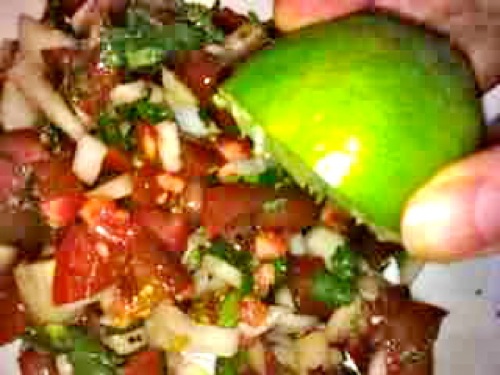
Superbowl-Worthy Traditional Mexican Salsa Fresca: A Step-by-Step Pictorial Guide
(excerpted from Diet Simple)
My fresh salsa is inspired by my Aunt Betse, who spends most of her days in San Miguel de Allende, Mexico, carrying on the tradition of my Grandfather who studied art there in the 1950s and 60s. Aunt Betse started making fresh salsa before Americans knew about it – decades ago. My salsa is a variation of hers. Use it as a dip or accompaniment at your next party. It goes fast, so make plenty! You can also use it in scrambled eggs, tortillas, or as a marinate or dressing. Throw it in plain yogurt or a mashed avocado as a dip. My measurements are the proportions I prefer, but you can vary any of the the ingredients depending on your preferences.
Serves 22
Ingredients:
1 large onion, diced (about 1/2 pound)
2 pounds fresh tomatoes, peeled, seeded, and chopped (start with about 3-1/2 pounds)
2 – 4 Jalapeno Peppers (1 – 2 ounces)
3/4 cup chopped fresh Cilantro
Ground pepper, to taste
1/2 teaspoon salt, or to taste
3 – 4 Tablespoons fresh lime juice (1 – 2 limes)
Peel the tomatoes, if you wish (I don’t always peel them), by dropping in simmering water for 10 seconds, pulling out with a fork, waiting until cool, then peel. Seed them if you’d like your salsa less watery, but this is also an optional step.With a sharp knife, chop the tomatoes.
Chop the onions and add to the tomatoes.
After removing the firey hot seeds, finely chop the jalapeno peppers and add to the mixture.
Chop the cilantro and add to mixture.
Add ground pepper and salt.
Squeeze the lime juice into the mixture and VOILA!
Nutrition Information per serving: 20 calories, 0 grams fat, 5 g carbohydrate, 1 g fiber, 1 g protein, 54 mg sodium
Super Bowl Chili with Fresh Salsa and Guacamole
- At February 04, 2012
- By Katherine
- In News, Recipes
 0
0
 Let’s watch some FOOTBALL! And, eat some delicious and spicy chili, salsa, guac and chips – the perfect SUPERBOWL FOODS.
Let’s watch some FOOTBALL! And, eat some delicious and spicy chili, salsa, guac and chips – the perfect SUPERBOWL FOODS.
They taste so good, no one will know they’re healthy. It’s called: THE “STEALTHY” HEALTHY SUPERBOWL PARTY!
Most guys I know love to watch football – even some gals. Left to their own devices, though, the food of choice may be chips, dogs, or other junk food. Here’s a way to go on the defense and tackle those calorie-laden, beer-belly-creating, artery-clogging snacks…
PIZZA, FOOT-LONG SUBS, SAUSAGES, FRIED AND BATTERED WINGS (150 calories each!) – they’re all popular sports-watching snacks. It’s what’s easy- and people are used to them. But I’ve found that when you serve healthy, tasty alternatives, they’re just as happy – just don’t announce it to everyone! In fact, words like “healthy” or “diet” are a huge turn-off for anyone – at any age – who loves good food. “Delicious!” is much more inviting. No one will know the difference, I promise! My experience is that your football lovers (uh, fanatics) will love these “stealthy, healthy” foods…
“Katherine’s Chili Non Carne” is an all-around favorite. Serve it with whole grain chips (yes, they’re fine this one time!), and add a few more bowls for dipping of Nonfat Greek Yogurt: NO ONE will know it isn’t sour cream, I swear! Fill other bowls with “Katherine’s Fresh Salsa” and “Guacamole.”
Grill beef or pork tenderloin, either as a roast or cut up on skewers, grill or broil veggies such as mushrooms, peppers, potatoes, eggplant… Make them crunchy on the outside and soft on the inside. They’ll taste as good as french fries – and this is coming from a french fry lover (yes, I must admit)!
What’s not to love? The Washingtonian agrees!
Katherine’s Chile Non-Carne
(excerpted from Diet Simple)
Try making this recipe a day ahead of time so the flavors and textures have a time to develop. I love this simple, quick chili recipe. It’s meatless but you don’t miss the meat because it’s so flavorful. You should use the amount of garlic or chili powder that appeals to you. I like it hot and spicy! I double the recipe, using a whole pound of dried black beans, so I have plenty for the week. I use this dish as a lunch or dinner alongside a green salad. I also serve it at parties as a dip next to my fresh tomato salsa, nonfat Greek yogurt, and guacamole. It’s perfect rolled up in a tortilla or stuffed in a taco with some reduced fat cheese. Great for informal super bowl or Halloween parties.
Serves 4
1 Tbsp Olive or Canola Oil, or more
1 Large Onion, Chopped
3 Large Garlic Cloves, Minced (more or less)
3 Tbsp Hot Chile Powder (try 50/50 Chipotle Chile, maybe a dash of smoked paprika, called “Pimenton,” and just a pinch of cinnamon)
1 Large Fresh Green Pepper,
Chopped1 28- oz. Can Italian Plum Tomatoes, chopped, including the liquid
1 Pound Can Kidney or Black Beans, whichever is preferred
1/2 Cup Water (To Hydrate the Bulgur)
1/2 Cup Bulgur (Cracked Wheat)
2 Seeded Jalapeno Peppers, chopped, if desired
Salt and Pepper to Taste
Saute the onions and garlic in the oil over low heat in a large pot until soft, 15 or more minutes. Add the chile powder and simmer for a few more minutes. Add the Fresh Green Pepper and cook until al dente.
Meanwhile, soak the bulgur in the boiling water for 15 minutes.
Add all remaining ingredients including the bulgur and simmer slowly over low to medium heat until flavors are well blended and vegetables are cooked to the desired consistency … a few minutes or longer, if desired. Adjust seasonings to your preference. Since many canned items were used, additional salt will probably not be needed.
Calories per serving 320, Total Fat 7g, Saturated Fat 1g, Carbohydrate 59g, Fiber 13g, Protein 12g
Katherine’s Spicy Fresh Mexican Salsa with Mild Guacamole
(excerpted from Diet Simple)
Katherine’s Spicy Mexican Salsa
(step-by-step pictorial instructions)
22 servings
Ingredients
1 large onion, peeled and chopped (about ½ pound)
2 lbs fresh tomatoes, peeled, seeded and chopped (start with about 3-1/2 lbs) (Use canned tomatoes, if good tomatoes aren’t available)
3 – 4 jalapeno peppers (1 – 2 ounces), to taste
¼ cup chopped fresh cilantro
½ tsp salt, or to taste
3 – 4 Tbsp fresh lime juice (1 – 2 limes)
Add the onion to the tomatoes. Finely chop 2 of the jalapeno peppers to start with. Taste. If you desire more heat, add 1 – 2 more jalapenos. Mix in the cilantro. Add the salt depending on your taste. Mix in the lime juice.
20 calories, 0 g fat, 5 g carb, 1 g fiber, 1 g protein
Katherine’s Guacamole
(step-by-step pictorial instructions)
12 Servings
Ingredients
2 ripe avocados
1/3 cup chopped fresh cilantro
2 Tbsp lime juice
¼ tsp salt, or to taste
freshly ground black pepper, to taste
Cut avocados in half lengthwise and pull out the pits. Scoop out the meat. Place ina medium bowl and mash, keeping some large chunks. Mix in the cilantro, lime juice and salt. Taste to adjust seasoning.
50 calories, 5 g fat, 1 sat fat, 3 g carbs, 2 g fiber, 1 g protein
A ‘So-Called Bad Food?” Uncovering the Egg Myth…
- At January 15, 2012
- By Katherine
- In News, Recipes
 0
0
The Much-Maligned Egg Deserves More Respect! See the report on CNN…
Recipe below…
My grandmother’s favorite food in the whole wide world was eggs. She loved eggs so much, we named an egg after her. The “grandmommy egg” was soft-boiled, for three minutes. As it sat in an egg cup, we would slice off the top third so the runny yolk would form a delicious and naturally creamy sauce for the white.
Unfortunately, during the last decades of her life, my grandmother came to see eggs as poison and avoided one of her real food pleasures. Health authorities were warning the public against eating eggs for fear that they were a major cause of high cholesterol levels — the bad kind, low-density lipoprotein, known as LDL — and increased risk of heart disease.
New studies show that the caution may have been an exaggeration. Yes, increased blood cholesterol levels can raise the risk of heart disease. Eggs are high in dietary cholesterol. But does eating eggs raise blood cholesterol and cause heart disease? This is where the story gets somewhat complicated, so stay with me, folks, and I’ll try to make sense of all of this.
First, the research: Most epidemiological research — the kind of research that studies large populations over time and analyzes their diets and their health — has found no connection between eating eggs and increases in heart disease. On the other hand, controlled clinical studies — where researchers feed subjects specific amounts of cholesterol and measure the effect on blood — do show a slight increase in blood cholesterol with increases in dietary cholesterol, though how much depends on genetic factors.
Cholesterol is an important component of all human and animal cells and influences hormone biology, among other functions. Since your body naturally has all it needs, there is no dietary requirement for cholesterol. But the American diet contains plenty, since we eat a lot of animal products. All animal products contain some cholesterol, but they also contain saturated fat, an even more significant culprit in heart disease risk.
“The major determinant of plasma LDL level is saturated fat,” says Alice H. Lichtenstein, professor of nutrition science and policy at the Friedman School of Nutrition Science and Policy at Tufts University .
And while eggs are high in cholesterol (186 milligrams – 184 of those 186 in the yolk), they’re relatively low in saturated fat (1.6 grams in the yolk).
“In most people, for every 100 milligrams reduction in dietary cholesterol, one would predict a reduction in LDL levels of 2.2 points on average,” says Wanda H. Howell, professor of nutritional sciences at the University of Arizona.
In fact, during my 20 years of counseling people with high cholesterol, just reducing their saturated fat intake to a range of 4 percent to 7 percent of their calories, causes their blood cholesterols to plummet — a double benefit.
Interestingly, the Japanese, the biggest egg-eaters in the world (averaging 328 eggs consumed per person per year), have low levels of cholesterol and heart disease compared with other developed countries, especially the United States. Why? In part, it’s because they eat a diet low in saturated fat.
Americans do just the opposite. Research has shown that we usually have our eggs alongside foods high in saturated fat, such as bacon, sausage and buttered toast. This meal pattern raises LDL and makes the effect of eating eggs worse than it actually is.
So how many eggs can you eat? That depends on a number of factors. The American Heart Association no longer includes limits on the number of egg yolks you can eat, but it recommends that you limit your cholesterol intake to 300 milligrams daily, or 200 milligrams if you have heart disease or if your LDL is greater than 100. You decide where that cholesterol comes from!
Other experts go further and say an egg a day is fine.
“The amount that one egg a day raises cholesterol in the blood is extremely small, so small in fact that the increase in risk in heart disease related to this change in serum cholesterol could never be detected in any kind of study,” says Walter Willett, professor of epidemiology and nutrition at Harvard’s School of Public Health. “Elevations in LDL of this small magnitude could easily be countered by other healthy aspects of eggs.”
Based on the research, my recommendation is if you eat a healthful diet, go ahead and eat an egg a day. On the other hand, if your cholesterol is high and if you eat the typical American diet — high in saturated fat, devoid of fruits, vegetables and fiber — maybe you shouldn’t be eating an egg a day.
But will taking eggs out of an unhealthy diet make a positive difference? Probably not. I can’t tell you how many times during my career I’ve heard people say, “I’ve cut out eggs, but my cholesterol is still high!” The impact of a healthy, balanced diet cannot be denied here.
Original content by Katherine Tallmadge for The Washington Post.
Good for You
Assuming you’re eating a healthy diet, here are some ways you may benefit by eating eggs
PROTEIN Eggs are considered the gold standard that other proteins are measured against. Because of the superior amino acid mix, an egg’s six grams of protein are absorbed easily and used by the body more efficiently. The egg is also economical and calorie- controlled (74 calories).
CHOLINE Yolks are one of the best sources of this essential nutrient. Choline is needed for brain development in a growing fetus and may also be important for brain function in adults.
LUTEIN and ZEAXANTHIN These two important beneficial phytochemicals found in egg yolks (as well as kale and spinach) help prevent eye diseases, especially cataracts and age- related macular degeneration. While eggs contain less lutein and zeaxanthin than greens, these phytochemicals are more absorbable because of the presence of fat in the yolk.
VITAMIN D Eggs are one of the few natural sources of Vitamin D, important for the bones and teeth. Vitamin D helps the absorption of calcium, which is important for the heart and colon as well.
Eggs Scrambled with Onion, Garlic and Sweet Cherry Tomatoes
This is a regular meal for me any time of the day – quick, easy, delicious, nutritious!
Servings: 1
Saute 1/4 sweet onion and a smashed garlic clove over medium high heat in 1 teaspoon canola or olive oil until almost soft. Add a handful of chopped tomatoes to the pan (or any other vegetables you happen to have such as chopped spinach, kale, mushrooms, or peppers) and cook for another 5 minutes. Turn down heat to very low. In a separate bowl, whisk 2 eggs. Pour eggs into the pan containing the onion, garlic and tomato – add 1 ounce low fat cheese, if you wish. Stir continuously until eggs are cooked. Pour over toasted whole rye bread.


